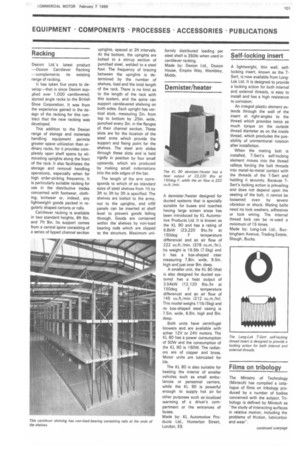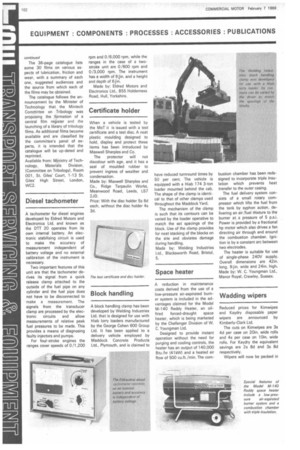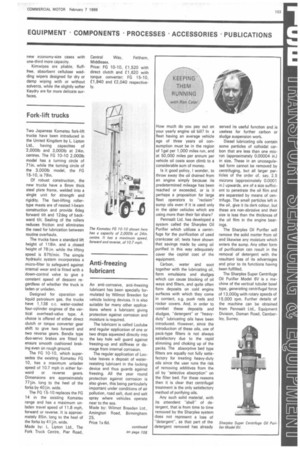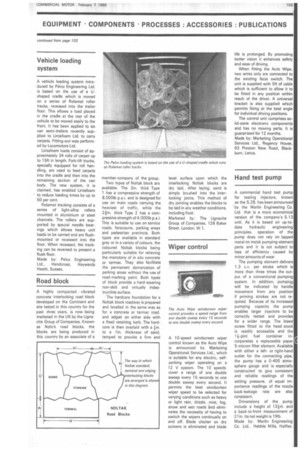Dexion Ltd.'s latest product —Dexion Cantilever Racking – -complements its existing range of racking.
Page 103

Page 104

Page 105

Page 107

If you've noticed an error in this article please click here to report it so we can fix it.
It has taken five years to develop—that is since Dexion supplied over 1,000 cantilevered, slotted angle racks to the British Shoe Corporation. It was from the experience gained in the design of the racking for this contract that the new racking was developed.
This addition to the Dexion range of storage and materials handling equipment permits greater space utilization than ordinary racks, for it provides completely open shelf spans by eliminating uprights along the front of the rack. It also facilitates the storage and removal handling operations, especially when for high order-picking frequency. It is particularly suitable racking for use in the distributive trades concerned with footwear, clothing, knitwear or, indeed, any lightweight goods packed in regularly shaped cartons or rolls.
Cantilever racking is available in two standard heights, 6ft 6in. and 7ft 9in. Its support comes from a central spine consisting of a series of lipped channel section uprights, spaced at 3ft intervals. At the bottom, the uprights are bolted to a stirrup section of punched steel, welded to a steel foot. The frequency of bracing between the uprights is determined by the number of shelves, load and the total length of the rack. There is no limit as to the length of the rack with this system, and the spine can support cantilevered shelving on both sides. Each upright has vertical slots, measuring 2in. from top to bottom by .25in. wide, punched every 3in. in the flanges of their channel section. These slots are for the location of the steel arms which provide the support and fixing point for the shelves. The steel arm slides through these slots and is held rigidly in position by four small upstands, which are produced by making small indentations into the side edges of the bar.
The length of the arm corresponds to which of six standard sizes of steel shelves from lft by 3ft to 3ft by 3ft is specified. The shelves are bolted to the arms, not to the uprights, and infill panels can be inserted at shelf level to prevent goods falling through. Goods are contained within the shelves by non-load bearing rods which are clipped to the structure. Maximum uni
formly distributed loading per steel shelf is 350Ib when used in cantilever racking.
Made by: Dexion Ltd., Dexion House, Empire Way, Wembley, Middx.
A demister /heater designed for ducted systems that is specially suitable for buses and coaches having large screen areas has been introduced by KL Automotive Products Ltd. It is known as the KL 90 and has a rating of 6.8kW (23,220 Btu /hr at 150deg F temperature difference) and an air flow of 222 cu.ft. /min. 1378 cu.mihr.). Rs weight is 16.51b (7.5kg) and it has a box-shaped case measuring 7.8in. wide, 9.5in. high and just over 9in. deep.
A smaller unit, the KL 80 (that is also designed for ducted systems) has a heat output of 3.54kW (12,120 Btu /hr at 150deg F temperature difference) and an air flow of 145 cu.ft./min (212 cu.m./hr). This model weighs 11Ib (5kg) and its box-shaped steel casing is 7.5in. wide. 6.9in. high and Sin. deep.
Both units have centrifugal blowers and are available with either 12V or 24V motors. The KL 80 has a power consumption of 50W and the consumption of the KL 90 is 160W. The radiators are of copper and brass. Motor units are lubricated for life.
The KL 80 is also suitable for heating the interior of smaller vehicles such as small ambulances or personnel carriers, while the KL 90 is powerful enough to supply hot air for other purposes such as localized warming of a driver's compartment or the entrances of buses.
Made by: KL Automotive Products Ltd., Homerton Street, London, E9. A lightweight, thin wall, selflocking insert, known as the TSert, is now available from LongLok Ltd. It is designed to provide a locking action for both internal and external threads, is easy to install and has a high resistance to corrosion.
An integral plastic element extends through the wall of the insert at right-angles to the thread which provides twice as much torque on the outside thread diameter as on the inside thread, which precludes the possibility of unintentional rotation after installation.
When the mating bolt is installed, T-Sert's self-locking element moves into the thread valleys forcing the bolt threads into metal-to-metal contact with the threads of the T-Sert and holding it securely. Because TSert's locking action is prevailing and does not depend upon the seating of the bolt, it cannot be loosened even by severe vibration or shock. Mating bolts need no lock washers, adhesives or lock wiring. The internal thread lock can be re-used a minimum of 16 times.
Made by: Long-Lok Ltd., Buckingham Avenue, Trading Estate, Slough, Bucks.
continued
The 36-page catalogue lists some 30 films on various aspects of lubrication, friction and wear, with a summary of each one, suggested audiences and the source from which each of the films may be obtained.
The catalogue follows the announcement by the Minister of Technology that the Mintech Committee on Tribology was proposing the formation of a central film register and the launching of a library of tribology films. As additional films become available and are classified by the committee's panel of experts, it is intended that the catalogue will be up-dated and reprinted.
Available from: Ministry of Tech nology, Materials Division, ICommittee on Tribology). Room 001, St. Giles' Court, 1-13 St. Giles' High Street, London, WC2.
Diesel tachometer
A tachometer for diesel engines developed by Eldred Motors and Electronics Ltd. and known as the OTT 20 operates from its own internal battery. An electronic stabilizing circuit is used to make the accuracy of measurement independent of battery voltage and no external calibration of the instrument is necessary.
Two important features of this unit are that the tachometer derives its signal from a quick release clamp attached to the outside of the fuel pipe on any cylinder and the fuel pipe does not have to be disconnected to make a measurement. The signals from the transducer clamp are processed by the electronic circuits and allow measurements of relative peak fuel pressures to be made. This provides a means of diagnosing faulty injectors and pumps.
For four-stroke engines the ranges cover speeds of 0/1,200 rpm and 0/6,000 rpm, while the ranges in the case of a twostroke unit are 0/600 rpm and 0/3.000 rpm. The instrument has a width of 91in. and a height and depth of 6iin.
Made by: Eldred Motors and Electronics Ltd., 855 Holdemess Road, Hull, Yorkshire.
Certificate holder
When a vehicle is tested by the MoT it is issued with a test certificate and a test disc. A neat plastic moulding designed to hold, display and protect these items has been introduced by Maxwell Sharpies and Co.
The protector will not discolour with age, and it has a seal of moulded rubber to prevent ingress of weather and condensation.
Made by: Maxwell Sharpies and Co., Ridge Tarpaulin Works, Meanwood Road, Leeds, LS7 2J D.
Price: With the disc holder 5s 6c1 each, without the disc holder 4s 3d.
Block handling
A block handling clamp has been developed by Welding Industries Ltd. that is designed for use with Hiab lorry loaders manufactured by the George Cohen 600 Group Ltd. It has been applied to a delivery vehicle employed by Maddock Concrete Products Ltd., Plymouth, and is claimed to have reduced turnround times by 50 per cent. The vehicle is equipped with a Hiab 174 3-ton loader mounted behind the cab. The shape of the clamp is identical to that of other clamps used throughout the Maddock Yard.
The mechanism of the clamp is such that its contours can be varied by the loader operative to match the set spacings of the block. Use of the clamp provides for neat stacking of the blocks on the site and obviates damage during handling.
Made by: Welding Industries Ltd., Blacksworth Road, Bristol, 5.
Space heater
A reduction in maintenance costs derived from the use of a low-pressure air-aspirated burner system is included in the advantages claimed for the Model M-140 Reddy Heater, an oilfired forced-draught space heater, which is being marketed by the Challenger Division of W. C. Youngman Ltd.
Designed to provide instant operation without the need for purging and cooling controls, the heater has an output of 140,000 Btu /hr (41 kW) and a heated air flow of 500 cult. /min. The com
bustion chamber has been redesigned to incorporate triple insulation which prevents heat transfer to the outer casing.
The fuel delivery system consists of a small rotary compressor which lifts the fuel from the tank by syphon action, delivering an air /fuel mixture to the burner at a pressure of 5 psi. Power is provided by a fractional hp motor which also drives a fan directing air through and around the combustion chamber. Ignition is by a constant arc between two electrodes.
The heater is suitable for use of single-phase 240V supply. Overall dimensions are 42in. long, 9",in. wide and 24in. high. Made by: W. C. Youngman Ltd., Manor Royal, Crawley, Sussex.
Wadding wipers
Reduced prices for Kimwipes and Kaydry disposable paper wipers are announced by Kimberly-Clark Ltd.
The cuts on Kimwipes are 3s 4d per case on 20in, wide rolls and 4s per case on 10in, wide rolls. For Kaydry the equivalent savings are 2s 8d and 3s 8d respectively.
Wipers will now be packed in new economy-size cases with one-third more capacity.
Kimwipes are pliable, flufffree, absorbent cellulose wadding wipers designed for dry or damp wiping with or without solvents, while the slightly softer Kaydry are for more delicate surfaces.
Fork-lift trucks
Two Japanese Komatsu fork-lift trucks have been introduced in the United Kingdom by L. Lipton Ltd., having capacities of 2,000lb and 3,000lb at 24in. centres. The FG 10-10 2,000lb model has a turning circle of 711n. while the turning circle of the 3,000lb model, the FG 15-10, is 79in.
Of robust construction, the new trucks have a 6mm thick steel plate frame, welded into a single unit for strength and rigidity. The fast-lifting rollertype masts are of nested I-beam construction and provide 6deg forward tilt and 12deg of backward tilt. Sealing of the rollers reduces friction and eliminates the need for lubrication between routine overhauls.
The trucks have a standard lift height of 11 Bin, and a ,closed height of 78;in. while the lifting speed is 87ft/min. The simple hydraulic system incorporates a micro-filter to safeguard against internal wear and is fitted with a down-control valve to give a constant speed of descent regardless of whether the truck is laden or unladen.
Designed for operation on liquid petroleum gas, the trucks have 1,138 c.c. water-cooled four-cylinder engines of the vertical overhead-valve type. A choice is offered of either direct clutch or torque converter gear shift to give two forward and two reverse gears. Bendix type duo-servo brakes are fitted to ensure smooth cushioned braking even on rough ground.
The FG 10-10, which supersedes the existing Komatsu FG 10, has a maximum unladen speed of 10.7 mph in either for ward or reverse gears. Dimensions are approximately 771in. long to the heel of the forks by 40 ,!in. wide.
The FG 15-10 replaces the FG 14 in the existing Komatsu range and has a maximum unladen travel speed of 11.3 mph, forward or reverse. It is approximately 85in. long to the heel of the forks by 41 in. wide.
Made by: L. Lipton Ltd., The Fork Truck Centre, Pier Road, Central Way, Feltha m , Middlesex.
Price: FG 10-10, £1,520 with direct clutch and £1,620 with torque converter; FG 15-10, £1,940 and £2,040 respectively.
An anti-corrosive, anti-freezing lubricant has been specially formulated by Wilmot Breeden for vehicle locking devices. It is also suitable for many other applications where a lubricant giving protection against corrosion and moisture is required.
The lubricant is called Loclube and regular application of one or two drops squeezed directly into the key hole will guard against freezing-up and stiffness or damage from internal corrosion.
The regular application of Loclube leaves a deposit of waterresisting lubricant in the locking device and thus guards against freezing. All the year round protection against corrosion is also given, this being particularly important under conditions of air pollution, road salt, dust and salt spray where vehicles operate near to the sea.
Made by: Wilmot Breeden Ltd., Amington Road, Birmingham 25.
Price 1s 6d. How much do you pay out on your yearly engine oil bill? In a fleet having an average vehicle age of three years oil consumption must be in the region of lgal per 1,000 miles run, and at 50,000 miles per annum per vehicle oil costs soon climb to a considerable sum of money.
Is it good policy, I wonder, to throw away the oil drained from an engine simply because its predetermined mileage has been reached or exceeded, or is it perhaps a proposition for large fleet operators to "reclaim" sump oils even if it is used only in the older vehicles which are using more than their fair share?
Pennsalt Ltd. has developed a system called the Sharpies Oil Purifier which utilizes a centrifuge for the purification of used crankcase oil; tests have shown that savings made by using oil purified in this way adequately cover the capital cost of the equipment.
Carbon, water and soot together with the lubricating oil, form emulsions and sludges which can cause blocking of oil ways and filters, and quite often form deposits on cold engine surfaces with which they come in contact, e.g. push rods and rocker covers. And, in order to combat these deposits and sludges, "detergent" or "heavydutylubricating oils have been introduced. However, since the introduction of these oils, use of pack-type filters is not always satisfactory due to the rapid slimming and choking up of the packs. The absorptive bed type filters are equally not fully satisfactory for treating heavy-duty oils since the user runs the risk of removing additives from the oil by "selective absorption" on the filter bed. For these reasons then it is clear that centrifugal treatment is the only satisfactory method of purifying oils.
Any such solid material, with its attendent "shell" of detergent, that is from time to time removed by the Sharpies system does not represent a loss of "detergent", as that part of the detergent removed has already served its useful function and is useless for further carbon or sludge suspension work.
Diesel lubricating oils contain some particles of colloidal car bon that are less than one mic ron (approximately 0.00004 in.) in size, These in an uncoagula ted form cannot be removed by centrifuging, but all larger particles of the order of, say, 2.5 microns (approximately 0,0001 in.) upwards, are of a size sufficient to penetrate the oil film and are separated by means of cen trifuge. The small particles left in the oil, give it its dark colour, but these are non-abrasive and their size is less than the thickness of the oil film in the engine bearings.
The Sharpies Oil Purifier will remove the solid matter from oil and likewise any moisture which enters the sump. Any other form of purification can result in the removal of detergent with the resultant loss of its advantages and prior to its functions having been fulfilled.
The Sharpies Super Centrifuge Oil Purifier Model 6V is a ma chine of the vertical tubular bowl type, generating centrifugal force of 13,000g with rotary speeds of 15,000 rpm. Further details of the machine can be obtained from Pennsalt Ltd., Equipment Division, Doman Road, Camberley, Surrey.
Vehicle loading system
A vehicle loading system introduced by Pelco Engineering Ltd. is based on the use of a Ushaped cradle which is moved on a series of Rolamat roller tracks, recessed into the trailer floor. This allows a load placed in the cradle at the rear of the vehicle to be moved easily to the front. It has been applied to six van semi-trailers recently supplied to Lintafoam Ltd. to carry carpets. Fitting-out was performed by Locomotors Ltd.
Lintafoam loads consist of approximately 34 rolls of carpet up to 15ft in length. Fork-lift trucks, specially equipped for roll handling, are used to feed carpets into the cradle and then into the remaining section of the van body. The new system, it is claimed, has enabled Lintafoam to reduce loading times by up to 50 per cent.
Rolamat tracking consists of a series of light-alloy rollers mounted in aluminium or steel channels. The rollers are supported by special needle bearings which allows heavy unit loads to be carried and are flushmounted or recessed into the floor. When recessed, the tracking can be reversed to present a flush floor.
Made by: Pelco Engineering Ltd., Handcross, Haywards Heath, Sussex.
Road block
A highly compacted vibrated concrete interlocking road block developed on the Continent and site tested in this country for the past three years, is now being marketed in the UK by the Lignacite Group of Companies. Known as Nolti-• k road blocks, the blocks are being produced in this country by an associate of a member-company of the group.
Two types of Noltak block are available. The 3in. thick Type 1 has a compressive strength of 8.000lb p.s.i. and is designed for use on main roads carrying the heaviest of traffic, while the
thick Type 2 has a compressive strength of 4,000 lb p.s. i. This is suitable to use on service roads, forecourts, parking areas and pedestrian precincts. Both types are available in standard grey or in a variety of colours, the coloured Noltak blocks being particularly suitable for relieving the monotony of in situ concrete or tarmac. They also facilitate the permanent demarcation of parking areas without the use of road-marking paint. Both types of block provide a hard-wearing non-skid and virtually indestructible surface.
The hardcore foundation for a Noltak block roadway is prepared and levelled in the same way as for a concrete or tarmac road. and edged on either side with a fixed retaining kerb. The hardcore is then overlaid with a lin. to a 1in. thickness of sand, tamped to provide a firm and level surface upon which the interlocking Noltak blocks are dry laid. After laying, sand is simply brushed into the interlocking joints. This method of dry jointing enables the blocks to be laid in any weather conditions, including frost.
Marketed by: The Lignacite Group of Companies, 128 Baker Street, London, W.1.
A 10-speed windscreen wiper control known as the Auto Wipe is announced by Marketing Operational Services Ltd., which is suitable for any electric, selfparking wiper operating on a 12 V system. The 10 speeds cover a range of one double sweep every 15 seconds to one double sweep every second. It permits the best windscreen wiper speed to be selected for varying conditions such as heavy or light rain, drizzle, mist, fog, snow and wet roads 'and eliminates the necessity of having to switch the wipers continually on and off. Blade chatter on dry screens is eliminated and blade life is prolonged. By promoting better vision it enhances safety and ease of driving.
When fitting the Auto Wipe, two wires only are connected to the existing facia switch. The unit is supplied with 5h of cable which is sufficient to allow it to be fitted in any position within reach of the driver. A universal bracket is also supplied which permits fixing at the best angle for individual driving positions.
The control unit comprises solid-state electronic components and has no moving parts. It is guaranteed for 12 months.
Made by: Marketing Operational Services Ltd., Regency House, 63 Preston New Road, Blackburn, Lancs.
Hand test pump
A commercial hand test pump for testing injectors, known as the S.28, has been announced by the Merlin Engineering Co. Ltd. that is a more economical version of the company's S.13 unit. As it is based on up-to date hydraulic engineering principles. operation of the pump does not rely on lapped metal-to-metal pumping-element parts and it is not subject to loss of efficiency caused by minor amounts of wear.
The pumping element delivers 1.3 c.c. per stroke which is more than three times the output of a conventional pumping system. In addition, pumping will be indicated by handle movement from any position if priming strokes are not required. Because of its increased pumping capacity the pump enables larger injectors to be correctly tested and provides for a wider range. The bleed screw fitted to the head stock is readily accessible and the 1k-pint fuel container incorporates a replaceable paper 5-micron filter element. Available with either a leftor right-hand outlet for the connecting pipe, the pump has a 0-400 atmosphere gauge and is especially constructed to give consistent and reliable readings of the setting pressure. of equal importance readings of the nozzle back-leakage rate are also consistent.
Dimensions of the pump include a height of 134in. and a back-to-front measurement of 21 in. Its net weight is 191b.
Made by: Merlin Engineering Co. Ltd., Hebble Mills, Halifax.












































































































































































